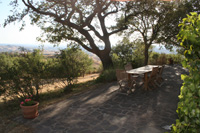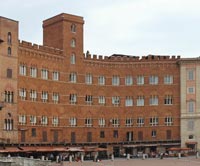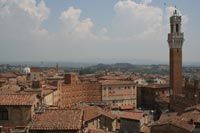| |
|
Tavarnelle Val di Pesa is a small and nice town situated in the south of Florence province, on the border between Sienna and the Chianti territory. It rises at 378 m above the sea level.
Since 1898 Tavarnelle is a municipality. There were gather together to its area the rural communities of Sambuca Val di Pesa and San Donato in Poggio, until that time governed by the neighbouring Barberino Val d’Elsa.
The area of Tavarnella Val di Pesa was already thickly populated in the 8th and 7th centuries BC circa as testified by the main Etruscan settlements which had been there founded.
Its name derives from the Latin word Tabernulae (tavern) due to the ancient ones emplaced in the 8th century AD along Via Cassia offering food and drinking to people on journey there and back from Florence to Sienna.
In the High Middle Age, as well as in the earlier Lower Middle Age, the area was under the dominion of some noble dynasties like the Albero and the Buodelmonti ones.
In the first half of the 13th century the area passed under the power of Florence.
In those times the main districts in the area were the Abbey of Passignano, Sambuca Val di Pesa and San Donato in Poggio. In the latter one, in 1176 and 1255, were signed two peace treaties between Florence and Sienna. But in 1260 Florence army was already organized in the Castle of San Donato to fight against Sienna in the famous Battle of Montaperti (4th September 1260). The Guelphs of Florence - supported by their Tuscan allies – were conducted by Bocca degli Abati. They moved an army of 35,000 men circa against the Ghibellines of Sienna. In spite of the great contingent of German cavalry sent by King Manfred of Sicily, the Ghibellines of Sienna could only put up an army of about 20,000 men led by the Count of Arras. Nevertheless, the day was won by Sienna.
It is said that the defeat of Florence was instigated by the treason of Bocca degli Abati, who was at heart a Ghibelline. In the 14th century Dante Alighieri positioned Bocca degli Abati in the ninth circle of Hell of the “Divina Commedia”.
In the last decade of the 15th century one of its main districts, the Abbey of Passignano which belonged to the Vallambrosani monks was seized by the troops of Lorenzo the Magnificent. His second son, Giovanni de Medici returned the Abbey to the Vallombrosani. He became Pope Leone X on the 11th March 1513.
Nowadays Tavarnelle Val di Pesa is a prosperous municipality particularly due to its production of wine, extra virgin olive oil and wheat, as well as by the morocco leather manufacturing and paper, furniture and machinery industries. |
|
|
|
| |
|
Main monuments
|
|
|
- The Church of S. Lucia al Borghetto. Former a Franciscan convent erected in the 13th century. Its single nave maybe is the most remarkable religious architectural in Gothic style in the Chianti territory.
- The Vallombrosan Monastery of Badia di Passignano: Located in the nearness of Tavarnelle is a huge architectural, religious and historical sight.
San Donato in Poggio
The town is small but it still conserves its medieval heritage. The heart of the town is still surrounded by the defensive walls built in the 12th century. The imposing Palazzo Malaspina dominates one corner and right next to it is the Gothic church Santa Maria della Neve with its side facing the square. The Pieve di San Donato, built in Tuscan Romanesque style, dates back to the year 989. It rose on the “via Sanese”, a road much traveled by Florentines heading toward Siena.
|
|
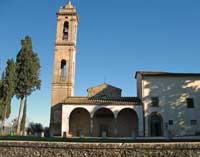
Tavarnelle Val di Pesa, Pieve di San Pietro in Bossolo |
| |
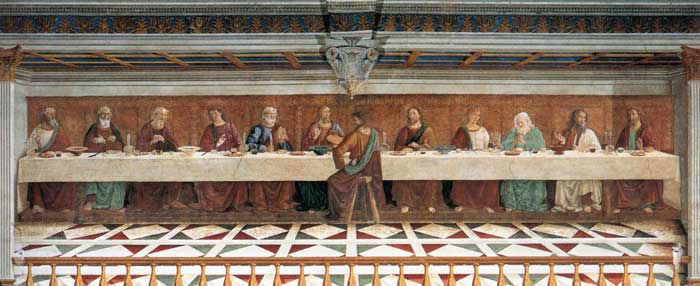
|
"In the centre of the painting stand the two main actors of the great drama: Judas, aware of his betrayal, with his stance, his look, his hair in disorder, expresses his gloomy solitude; Christ, with an expression of religious solemnity, looks towards the table with his right hand raised as a sign of blessing and seems almost comforted by the presence of John who, in that moment, stands with his head resting against the Lord's chest". (P.N. Vasaturo, 1989).
Ghirlandaio painted the scene of the Last Supper on several occasions within the space of a few years. In all three works of his that still remain, the basic arrangement is the same as that in the fresco by Andrea del Castagno in the Florentine Cenacolo di Sant'Apollonia dating from about 1450[1]. The disciples are sitting at a long table in front of a rear wall that runs parallel to the picture plan. Christ is sitting in the centre, and His favourite disciple John is leaning sadly against Him. To the right of Christ, in the place of honour, is the chief Apostle, Peter. Judas the traitor is the only one to be separated from the others: he is seated in front of the table.
The earliest example of the Last Supper was painted in 1476 by Ghirlandaio in the abbey of San Michele Arcangelo a Passignano (in Tavernelle Val di Pesa, near Florence). This is strongly influenced by Andrea del Castagno. The Apostles and Christ are sitting together in a room with a flat ceiling that appears to be too low. Judas is sitting opposite Christ on a three-legged stool in front of the laid table. The figures are set back some distance from us, to a depth of three large floor tiles. The various emotions of the Apostles are indicated by stiff hand movements that scarcely seem alive and express little of the character of the individuals.
Art in Tuscany | Domenice Ghirlandaio, Last Supper frescoes
Art in Tuscany
| Last Supper Frescoes of Florence
|
|

Domenice Ghirlandaio, Last Supper, 1476, fresco, Abbazia di San Michele Arcangelo a Passignano, Tavernelle Val di Pesa
 Andrea del Castagno, Last Supper in the Florentine Cenacolo di Sant'Apollonia Andrea del Castagno, Last Supper in the Florentine Cenacolo di Sant'Apollonia
|
|
Frazioni Badia a Passignano, Bonazza, Chiostrini, Madonna di Pietracupa, Magliano, Morrocco, Noce, Palazzuolo, Pontenuovo, Romita, Sambuca Val di Pesa, San Donato in Poggio, San Michele, San Pietro in Bossolo, Spoiano
Comuni confinanti Barberino Val d'Elsa, Castellina in Chianti (SI), Certaldo, Greve in Chianti, Montespertoli, San Casciano in Val di Pesa
|
|
|
| |
|

Podere Santa Pia is situated in a breathtaking position and also is near to the most important Tuscan and Umbrian art cities. This charming holiday home is situated in the province of Grosseto,It sits upon the highest hill of a picturesque landscape in a peacefull position, three miles from the village of Castiglioncello Bandini, in the hearth of the Valle d'Ombrone, near the Val d'Orcia, few miles from Montalcio, Pienza and Mount Amiata. Stunning views of the hills from the terraces.
|
| |
|
|
|
|
|
| |
|
|
|
|
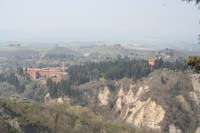
Monte Oliveto Maggiore abbey |
|
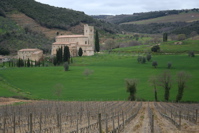
Abbey of Sant 'Antimo |
|
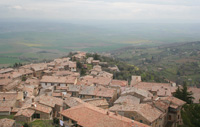
Montalcino |
| |
|
|
|
|
|
|
|
|
|
Siena, duomo |
|
Siena, Palazzo Sansedoni |
|
Siena, Piazza del Campo |
This page uses material from the Wikipedia article, published under the GNU Free Documentation License.

[1] During the 15th century, with invention of perspective, the Supper began to be represented independently on an entire wall. The "squared cut", already used by Giotto in the Scrovegni Chapel in Padua and then by Taddeo Gaddi in the Florentine Last Supper in Santa Croce, looks forward to the strongly compressed cubic space bathed in light of Andrea del Castagno's monumental Supper in Santa Apollonia. The frescoed representations of the Last Supper by Domenico Ghirlandaio in Florence and in the Abbey at Passignano, which just predate Leonardo da Vinci's Last Supper in Milan, are characterized by a descriptive naturalism.
|
|
| |
|
|







